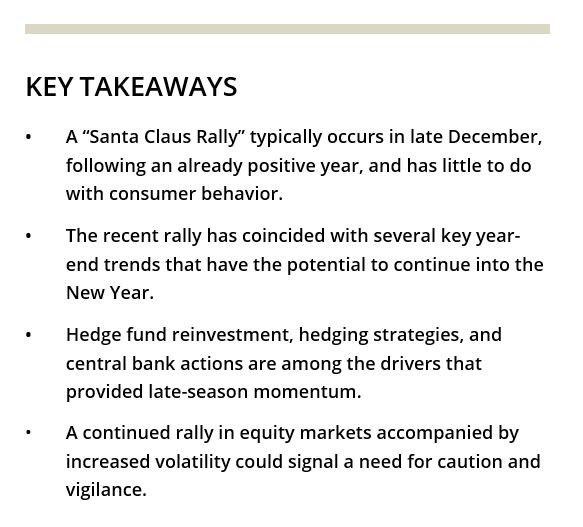Market Updates
Investment Perspective: Unwrapping the Market Dynamics Behind a “Santa Claus Rally”
Dec 21, 2023
Back to all posts.The recent surge in equity markets has been driven by several factors: continued strength in mega cap tech leadership, an apparent shift in Fed policy, expectations of an interest rate decline, and squeezes across a group of popular short positions. The recent rally gives reasons for caution, but recent strength has also created an environment ripe for a potential year-end “Santa Claus Rally” that could last into the New Year. 
Though the phenomenon known as the Santa Claus Rally has often attributed to the effects of the holiday season, historically it has resulted from a complex interplay of various market dynamics that are fueled by much more than milk and cookies or rampant retail activity.
Examining the recent equity market rally in the context of historical market behaviors, Fed policy, and investor sentiment reveals some intriguing insights into the market’s strength since October and the potential for a rally that could maintain momentum heading into 2024.
In this investment perspective, we delve into the mechanics that drove this rally, the historical patterns of past rallies, and examine what it could mean for markets in the New Year.
The Reason Behind the Season
The driving force behind the recent rally and a potential Santa Claus Rally is three-fold:
Portfolio Reinvestment
In an effort to maintain consistent risk levels, many large hedge funds attempt to strategically reinvest gains following a period of strong performance in equity markets. Large asset managers adjust exposures in order to meet their desired risk targets, which results in significant asset purchasing activity. This has often led to a year-end rally that extends into January.
Hedging Strategies by Hedge Funds
During bullish market environments, hedge funds have tended to employ hedging strategies using options and derivatives on broad market indices. However, this hedging activity has ultimately served to bolster market rallies and prevent the market pullbacks the activity aimed to guard against. As options approach expiration, dealers adjust their own underlying index exposures by purchasing the securities outright, amplifying market support and reinforcing rallies. This action is particularly prevalent during the weeks preceding options expiration (“Opex”) as these market flows increase on securities tied to hedges with out-of-the-money strikes. Opex dates around year-end have tended to be some of the largest option volumes of the year.
Central Bank Actions
Statements or actions from central banks can have an outsized influence on markets. Recent statements by the Federal Reserve, particularly Fed Chair Jerome Powell’s dovish tone, have contributed to equity market momentum, as investors believe rates have peaked. Speculation of potential rate reductions fueled gains—especially in rate-sensitive sectors—propelled by both buying and short
covering in areas of the market that have been largely unloved for most of the year.
Recent Observations
- The recent market rally has resulted in sharp losses in systematic trading strategies due to a brief sell-off of crowded momentum equities and shifts into high beta and high volatility stocks. In some cases, this has resulted in short squeezes in popular short positions.
- According to Goldman Sachs FICC and Equities Prime Services, December 14, 2023 was the worst single-day performance for systematic managers since it began tracking the group in 2016, reflecting significant market turbulence and repositioning of crowded trades.
- Positioning, both long and short, grew more crowded during the second half of 2023 until recently, when short books were quickly unwound and the top long winners lagged over the short term. Despite this brief disruption in trends, mega cap tech returned to leadership status and quickly resumed its march higher in the following market sessions. The unwinding of short portfolios was triggered by short-squeezes in numerous crowded individual short positions.
Is the Santa Claus Rally Real?
Ample data that shows a strong finish in years when performance was positive. Historically, a strong first half year of performance has preceded late-year rallies, particularly when markets surged heading into December. In 17 of the past 20 calendar years, the S&P 500 was positive in December when year-to-date gains exceeded 10% through November. This has been even more pronounced recently, occurring in 12 of the last 13 years.
Observations of Recent Year-End Market Behavior
2022
Market weakness and volatility dominated most of the year and the final weeks of December reflected this with further selling.
2021
The S&P 500 rallied in the last two weeks of the year despite most underlying stocks hitting peak levels earlier in the fourth quarter. The S&P 500 marked its all-time high on Jan 3, 2022 before falling off considerably just days later.
2020
A sustained rally off COVID-19 lows resulted in a positive year entering December and strength through the final days of the year.
2019
A strong year for equities led to a year-end rally with continued upside into January 2020, despite the emergence of COVID-19, which eventually triggered a market downturn in the first quarter of 2020 after year-end forces subsided.
2018
Volatility and negative performance into December was followed by a sharp decline post-Opex and volatile last days of the year.
Conclusion
The recent market rally has been driven by a confluence of factors; primarily declining interest rates, expected rate cuts by the Fed, improved corporate earnings, and short-covering of highly shorted, rate-sensitive equities. This positive momentum has historically improved the odds of a Santa Claus Rally in the year’s final market sessions that continues into early January.
However, January Opex has the potential to signal a vulnerability window as these seasonal factors dissipate. It is also possible recent Fed rhetoric alluding to conquering inflation could prove to be premature as stubborn structural inflation persists across global economies. A strong Santa Claus Rally into January may prove to be an opportune time for investors to trim gains and rebalance portfolios to ensure proper positioning in the event of an eventual rise in volatility and market weakness.
Please email info@primebuchholz.com for more information. ⬛
 REPORT BY GREGORY C. BERRY
REPORT BY GREGORY C. BERRY
Principal/Associate Director, Research